It was past 5 am. The uphill, winding road was unlit save for the beam of light coming from the car’s headlights. Darkness surrounded us, and the only thing keeping our nerves together was faint music coming from the radio. I couldn’t make out the song, but we talked in nervous chatter – hoping we don’t see anything come to view ahead. It had been almost ten minutes and we were still nowhere close to the Semenyih Dam.
Our pre-dawn adventure was the first time the three of us, the Blind Hikers, had embarked on an adventure after many years of life getting in the way. I had been away for many years, while the other two had went on to get married, and one was now even a father. Life had took many turns since our last adventure. And here we are now, driving into the darkness.
It wasn’t until fifteen minutes of slow driving had passed when we saw the glittering night sky on the horizon. It was difficult to make out, but we saw a signage: left for Kuala Klawang and right for Semenyih. We had finally arrived the Semenyih Dam.
We drove around, grasping in the dark for a vantage point where we could have a view of the lake and catch the sunrise. We hoped, in the best case scenario, that we would see a glimmering dawn. Part of that hope was dampened with the flashes among clouds we saw earlier – was rain coming? Would it instead be a grey, wet morning? We didn’t know but that was how we’ve always operated: in-between the vague promise of something amazing, or in the worst case, an uneventful outing. The latter happened rarely, even in the most least exciting of adventures.
We drove further down the road and stopped. There was a pathway. Adi however, brought the window down, sniffed the air and said, “I don’t think this is a safe spot. There’s an animal smell here”. The both of us didn’t ask but I suspected it was animal excrement, which was never a good sign when one is at the edges of the wilderness. We turned around and tried again for another vantage point, until we saw a lone car and two figures – staring into a distance.
We parked the car a little distance away, unsure. There was the three of us, and the two of them. At least in terms of numbers, we had some assurance. “Let’s just say Hi, and ask them if it’s okay we share the spot”, Adi suggested. Always the diplomatic one between the three of us. Adi however, stayed in as both Asyraf and I went out of the car and towards the two figures. We walked closer, a little nervous. Asyraf was ahead, guided by the silhouette of the two strangers. He introduced himself, asked if we could stay around – the two other persons, who too, seemed initially tense, was now less so and seemed okay with our presence.
You can never tell when it’s 5.30 am in the darkness of the morning.
We set up our equiptment and waited for the dawn. I looked upward. The stars were clear and glimmering. If there is another reason to come back to the dam, it would be for future stargazing. We had ahead of us however, a dawn to witness.
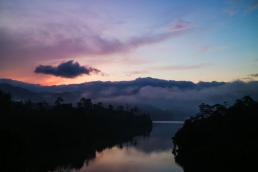
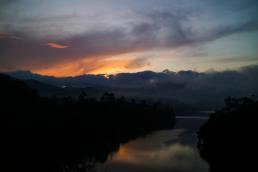

The beauty of the sunrise only lasted for 15-minutes. We spent the dawn in serenity (and with some good joking around), as we witnessed the sky turn from shades of indigo, to violet, to amber and finally, gold. At this point, some may argue that sunsets can be equally wonderful to behold. I don’t deny that – but there is always something more special about a sunrise. Whether it’s the signal of a new day, or whether influenced by the act of rising during a witching hour – sunrises, more so the perfect ones, are better than sunsets in this regard.
Everyone can catch a sunset, but not everyone can witness a sunrise.
Pak Din, the Bamboo-man
Not 5-minutes away from where we earlier were is a stall cum workshop. Driving past, one would see stacks of bamboo sticks, neatly piled on top under a shack. On bold capital letters, a stickered sign says: Pembekal Buluh-Lemang. Pak Din.
Pak Din, a man who looks to be in his sixties, cracks jokes as he sawed long bamboo trunks into sticks. In a minute, he was able to cut up about at least ten 1-2 feet long bamboo sticks. These, he explained, were mainly sold to entrepreneurs who made lemang, the quintessential Raya dish typically enjoyed with a side of slow-simmered rendang, whether beef or chicken. At RM1 per stick, he usually sells them by the hundreds and orders would go up typically around Ramadhan when businesses prepare for Raya celebrations.
Pak Din lives across the road, in a small modest home with an impressive nursery. I say impressive because I spotted a number of orchids among other flowers and vegetation. To many an amateur like myself, orchids have a reputation for being difficult to grow. Horticulture appears to be one of Pak Din’s many interests. Another is his former love of bee-keeping stingless bees, or lebah kelulut, which he was in the business of for many years before he recently moved into bamboo trading.
“I’ve been doing this [bamboo business] for almost twelve years now”, he shares.
Pak Din also demonstrates how to cook lemang, without the glutinous rice. He cuts up a banana leaf to size, rolls it up and slots it into one of his freshly-cut bamboo sticks. “There. Now all you need is a fire and the rice”.
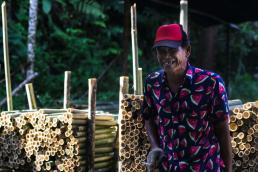

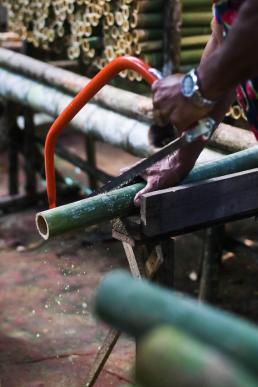


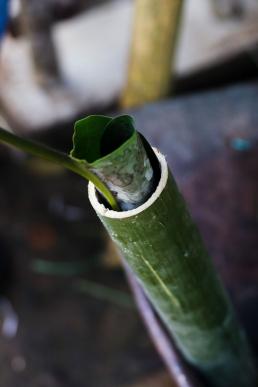
Selling bambo sticks at RM1 is not a path to quick profit, but it’s good enough. He explains his supply chain: how the local Orang Asli in the area forage and search the surrounding jungle for bamboo and sell it to him. The sale however, goes through the Penghulu, chief villager, who takes a cut for the provision of his villagers’ labour. It is the social order of things, in communities of heirarchy.
“My wife is an Orang Asli. I’m a Malay” he laughed when we asked of his ethnicity. He points towards a steep road uphill, diverging from the main road – an Orang Asli settlement located not a stone’s throw away from himself. While he did not say it, there is an implied suggestion of his wife having originated from the village. She was there at the stall with him when we spoke, sometimes laughing at his wisecracks, sometimes eye-rolling. There is a natural chemistry to their decades-long relationship. I did not need to ask, but could witness for myself.
Pak Din, too, it appears, to be someone well-known in the area. While we were there, another burly man much younger than him was around. “Pak Din taught me everything about bee-keeping – he’s like a teacher”. Pak Din, though having left the bee-keeping enthusiasm, clearly was still knowledgable in it. The man (whose name we did not get), shared that Pak Din taught him with no expectation; no trade-passing-of-the-torch nor a profit cut. Only long days when the man would tend to his two bee-hives under the instructive mentorship of Pak Din.

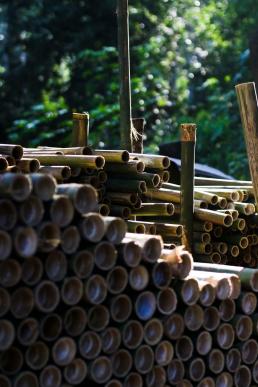
We drove ahead, further down the road. Our conversation with Pak Din was insightful and we left with three souvenirs of a bamboo stick each. The road led further into Kuala Klawang, Negeri Sembilan. It was an interstate trunk road, one of the many that network across the Peninsular. While conventional roads and highways into Negeri Sembilan was on flat land, those who seek for craggy vistas typically find themselves down the winding roads of Route 32.
As we drove uphill, we passed by a countless number of cyclists, sweating profusely as they pedalled up the hill. Asyraf also shared that the N23 was also where (lawless) motor-racing often happened. They would typically rendezvous at the highest point, between the state borders, at Jelebu.
As we drove closer, we spotted the border sign. It was a simple signange with the Negeri Sembilan traditional roof as its head. On it was written: Selamat Datang ke Negeri Sembilan. Not many seconds after crossing the imaginary state line, we spotted a goup of youngsters in motorbikes. Was there a race ready to happen? We did not stick around. They chatted while looking at us cautiously as I performed a three-point turn and returned back Selangor-side.
“This route is notorious for accidents” Asyraf shared, as I took a sharp corner. I could see why. At high speeds and sharp corners, racing motorcyles have the risk of understeering, leading to accidents that are commonplace on the Route 32. We prayed that no race would take place that morning, and that the youngsters we saw earlier were just hanging out as part of a convoy.
The sun was above our heads as we closed back in to Semenyih Dam. It was almost noon, and our early dawn adventure had clocked into its eight hour. We turned into Sungai Gabai’s route instead as an alternative, and passed by countless of smaller houses along the way. It was a good fifteen-minutes before we finally merged back into the main Hulu Langat road. As we turned back into the city, we reminisced old adventures of the years before – and made a pact for future ones to come.
The Blind Hikers are back.
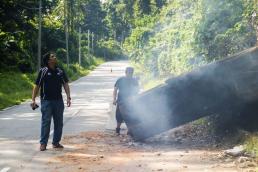

Asyraf has uploaded a video-travelogue of the Semenyih trip on his newly-made YouTube channel, Jalan Lihat Dengar. Check the video out below!